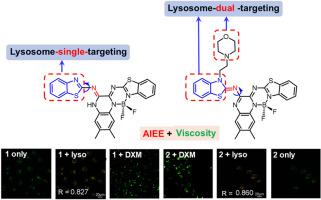喹诺啉衍生的aza-BODIPY AIEE荧光探针用于溶酶体粘度成像
IF 4.2
3区 工程技术
Q2 CHEMISTRY, APPLIED
引用次数: 0
摘要
本研究通过一锅希夫碱反应合成了两种新型的喹诺沙林衍生的aza-BODIPY荧光探针(1和2),它们对溶酶体粘度有响应。两种探针都具有通过CN键连接的可旋转苯并噻唑基团,而探针2包含一个morpholine片段以增强溶酶体靶向性。单晶x射线衍射证实,啉基团增加π电子离域,影响分子堆积。两种探针都表现出具有大斯托克斯位移的紫外可见吸收和发射特性。由于吗啡啉的给电子作用,探针2出现了红移。在两种探针中均观察到聚集诱导发射增强(AIEE)。两者都对黏度(2-610 cP)表现出强烈的线性荧光响应,增强高达24倍,检测限低(0.27和0.26 cP)。在MTT试验中,它们表现出对生物干扰物极好的选择性和可忽略不计的细胞毒性。共定位实验显示探针2比探针1具有更好的溶酶体靶向性(R = 0.86),这归因于苯并噻唑和morpholine基团的双重靶向作用。两种探针都成功监测了活细胞中地塞米松诱导的溶酶体粘度变化(10-40 μM),实现了对溶酶体微环境的实时跟踪。探针2始终表现出比探针1更强的荧光强度,突出了其更高的灵敏度和检测性能。这些发现表明,这些基于aza- bodipy的探针有潜力成为实时细胞内粘度成像和溶酶体相关疾病研究的有效工具。本文章由计算机程序翻译,如有差异,请以英文原文为准。

Quinoxaline-derived aza-BODIPY AIEE fluorescent probes for lysosomal viscosity imaging
In this study, two novel quinoxaline-derived aza-BODIPY fluorescent probes (1 and 2) responsive to lysosomal viscosity were synthesized via a one-pot Schiff base reaction. Both probes feature a rotatable benzothiazole group linked via a C![]() N bond, while probe 2 incorporates a morpholine moiety to enhance lysosomal targeting. Single-crystal X-ray diffraction confirmed that the morpholine group increases π-electron delocalization and affects molecular stacking. Both probes exhibited characteristic UV–visible absorption and emission with large Stokes shifts. Probe 2 showed a red-shift due to the electron-donating effect of morpholine. Aggregation-induced emission enhancement (AIEE) was observed in both probes. Both displayed strong linear fluorescence responses to viscosity (2–610 cP), with up to 24-fold enhancement and low detection limits (0.27 and 0.26 cP). They demonstrated excellent selectivity over biological interferents and negligible cytotoxicity in MTT assays. Co-localization experiments revealed better lysosomal targeting for probe 2 (R = 0.86) compared to probe 1 (R = 0.83), attributed to the dual-targeting effect of the benzothiazole and morpholine groups. Both probes successfully monitored dexamethasone-induced lysosomal viscosity changes (10–40 μM) in live cells, enabling real-time tracking of the lysosomal microenvironment. Probe 2 consistently showed stronger fluorescence intensity than probe 1, highlighting its superior sensitivity and detection performance. These findings suggest the potential of these aza-BODIPY-based probes as effective tools for real-time intracellular viscosity imaging and lysosome-related disease research.
N bond, while probe 2 incorporates a morpholine moiety to enhance lysosomal targeting. Single-crystal X-ray diffraction confirmed that the morpholine group increases π-electron delocalization and affects molecular stacking. Both probes exhibited characteristic UV–visible absorption and emission with large Stokes shifts. Probe 2 showed a red-shift due to the electron-donating effect of morpholine. Aggregation-induced emission enhancement (AIEE) was observed in both probes. Both displayed strong linear fluorescence responses to viscosity (2–610 cP), with up to 24-fold enhancement and low detection limits (0.27 and 0.26 cP). They demonstrated excellent selectivity over biological interferents and negligible cytotoxicity in MTT assays. Co-localization experiments revealed better lysosomal targeting for probe 2 (R = 0.86) compared to probe 1 (R = 0.83), attributed to the dual-targeting effect of the benzothiazole and morpholine groups. Both probes successfully monitored dexamethasone-induced lysosomal viscosity changes (10–40 μM) in live cells, enabling real-time tracking of the lysosomal microenvironment. Probe 2 consistently showed stronger fluorescence intensity than probe 1, highlighting its superior sensitivity and detection performance. These findings suggest the potential of these aza-BODIPY-based probes as effective tools for real-time intracellular viscosity imaging and lysosome-related disease research.
求助全文
通过发布文献求助,成功后即可免费获取论文全文。
去求助
来源期刊

Dyes and Pigments
工程技术-材料科学:纺织
CiteScore
8.20
自引率
13.30%
发文量
933
审稿时长
33 days
期刊介绍:
Dyes and Pigments covers the scientific and technical aspects of the chemistry and physics of dyes, pigments and their intermediates. Emphasis is placed on the properties of the colouring matters themselves rather than on their applications or the system in which they may be applied.
Thus the journal accepts research and review papers on the synthesis of dyes, pigments and intermediates, their physical or chemical properties, e.g. spectroscopic, surface, solution or solid state characteristics, the physical aspects of their preparation, e.g. precipitation, nucleation and growth, crystal formation, liquid crystalline characteristics, their photochemical, ecological or biological properties and the relationship between colour and chemical constitution. However, papers are considered which deal with the more fundamental aspects of colourant application and of the interactions of colourants with substrates or media.
The journal will interest a wide variety of workers in a range of disciplines whose work involves dyes, pigments and their intermediates, and provides a platform for investigators with common interests but diverse fields of activity such as cosmetics, reprographics, dye and pigment synthesis, medical research, polymers, etc.
 求助内容:
求助内容: 应助结果提醒方式:
应助结果提醒方式:


